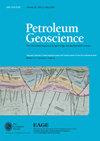Influence of fracture nucleation and propagation rates on fracture geometry: insights from geomechanical modelling
IF 2.1
4区 地球科学
Q3 GEOSCIENCES, MULTIDISCIPLINARY
引用次数: 11
Abstract
We combine a power-law microfracture size distribution function with an expression for fracture propagation rate derived from subcritical fracture propagation theory and linear elastic fracture mechanics, to derive a geomechanically based deterministic model for the growth of a network of layer-bound fractures. This model also simulates fracture termination due to intersection with perpendicular fractures or stress-shadow interaction. We use this model to examine key controls on the emergent geometry of the fracture network. First, we examine the effect of fracture propagation rates. We show that at subcritical fracture propagation rates, the fracture nucleation rate increases with time; this generates a very dense network of very small fractures, similar to the deformation bands generated by compaction in unconsolidated sediments. By contrast, at critical propagation rates, the fracture nucleation rate decreases with time; this generates fewer but much larger fractures, similar to the brittle open fractures generated by tectonic deformation in lithified sediments. We then examine the controls on the rate of growth of the fracture network. A fracture set will start to grow when the stress acting on it reaches a threshold value, and it will continue to grow until all the fractures have stopped propagating and no new fractures can nucleate. The relative timing and rate of growth of the different fracture sets will control the anisotropy of the resulting fracture network: if the sets start to grow at the same time and rate, the result is a fully isotropic fracture network; if the primary fracture set stops growing before the secondary set starts growing, the result is a fully anisotropic fracture network; and if there is some overlap but the secondary set grows more slowly than the primary set, the result is a partially anisotropic fracture network. Although the applied horizontal strain rates are the key control on the relative growth rates of the two fracture sets, we show that the vertical effective stress, the initial horizontal stress, the elastic properties of the rock and the inelastic deformation processes, such as creep, grain sliding and pressure solution, all exert a control on the fracture growth rates, and that more isotropic fracture networks will tend to develop if the vertical effective stress is low or if the fractures are critically stressed prior to the onset of deformation. Thematic collection: This article is part of the Naturally Fractured Reservoirs collection available at: https://www.lyellcollection.org/cc/naturally-fractured-reservoirs裂缝成核和扩展速率对裂缝几何形状的影响:来自地质力学建模的见解
我们将幂律微裂缝尺寸分布函数与基于亚临界裂缝扩展理论和线弹性断裂力学的裂缝扩展速率表达式结合起来,推导出基于地质力学的层状裂缝网络扩展的确定性模型。该模型还模拟了由于与垂直裂缝相交或应力-阴影相互作用而导致的裂缝终止。我们使用该模型来检查裂缝网络的紧急几何形状的关键控制。首先,我们考察了裂缝扩展速率的影响。结果表明,在亚临界断裂扩展速率下,断裂成核速率随时间增大;这产生了一个非常密集的非常小的裂缝网络,类似于松散沉积物中由压实作用产生的变形带。相反,在临界扩展速率下,断裂成核速率随时间减小;这产生了更少但更大的裂缝,类似于岩化沉积物中构造变形产生的脆性开放裂缝。然后,我们研究了对裂缝网络生长速度的控制。当作用在裂缝集上的应力达到一个阈值时,裂缝集就会开始生长,并将继续生长,直到所有裂缝都停止扩展,没有新的裂缝可以成核。不同裂缝组的相对生长时间和速率将控制所形成裂缝网络的各向异性:如果裂缝组以相同的时间和速率开始生长,则形成完全各向同性的裂缝网络;如果主裂缝组在次裂缝组开始生长之前停止生长,则形成完全各向异性裂缝网络;如果存在一定的重叠,但次生裂缝发育速度慢于次生裂缝发育速度,则形成部分各向异性裂缝网络。尽管施加的水平应变速率是控制两组裂缝相对扩展速率的关键因素,但我们发现,垂直有效应力、初始水平应力、岩石的弹性特性以及蠕变、晶粒滑动和压力解等非弹性变形过程都对裂缝扩展速率起着控制作用。如果垂向有效应力较低或裂缝在变形开始前处于临界应力状态,则倾向于发展更多的各向同性裂缝网。专题合集:这篇文章是自然裂缝油藏合集的一部分,可在:https://www.lyellcollection.org/cc/naturally-fractured-reservoirs
本文章由计算机程序翻译,如有差异,请以英文原文为准。
求助全文
约1分钟内获得全文
求助全文
来源期刊

Petroleum Geoscience
地学-地球科学综合
CiteScore
4.80
自引率
11.80%
发文量
28
审稿时长
>12 weeks
期刊介绍:
Petroleum Geoscience is the international journal of geoenergy and applied earth science, and is co-owned by the Geological Society of London and the European Association of Geoscientists and Engineers (EAGE).
Petroleum Geoscience transcends disciplinary boundaries and publishes a balanced mix of articles covering exploration, exploitation, appraisal, development and enhancement of sub-surface hydrocarbon resources and carbon repositories. The integration of disciplines in an applied context, whether for fluid production, carbon storage or related geoenergy applications, is a particular strength of the journal. Articles on enhancing exploration efficiency, lowering technological and environmental risk, and improving hydrocarbon recovery communicate the latest developments in sub-surface geoscience to a wide readership.
Petroleum Geoscience provides a multidisciplinary forum for those engaged in the science and technology of the rock-related sub-surface disciplines. The journal reaches some 8000 individual subscribers, and a further 1100 institutional subscriptions provide global access to readers including geologists, geophysicists, petroleum and reservoir engineers, petrophysicists and geochemists in both academia and industry. The journal aims to share knowledge of reservoir geoscience and to reflect the international nature of its development.
 求助内容:
求助内容: 应助结果提醒方式:
应助结果提醒方式:


